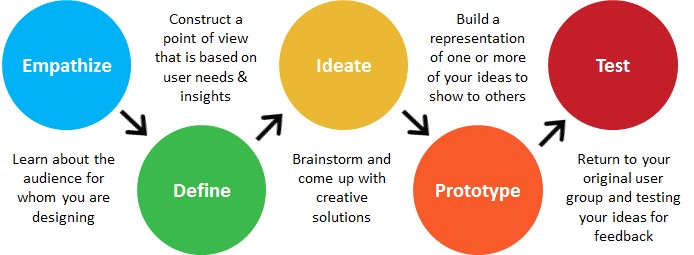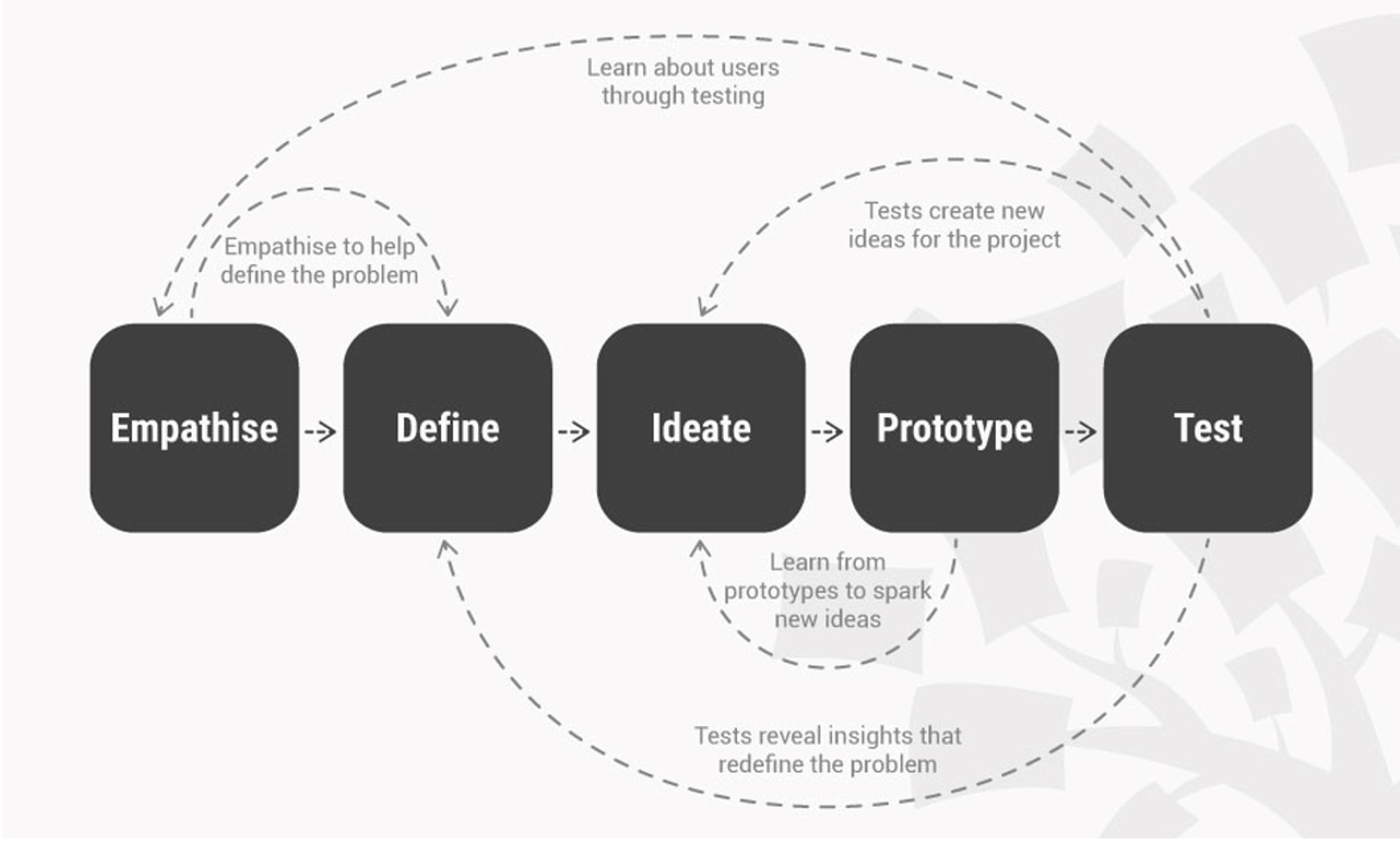Executive Summary
Do you want to utilize creativity and innovative thinking to solve complex problems, develop new strategies, and drive change towards a more sustainable and water-secure world? Great! You are in the right place. This factsheet will introduce you to one of the most innovative solution-oriented approaches that promote placing the human needs, requirements, environment, and contexts at the heart of the process, in this way allowing you to develop a deep understanding of the needs of your target groups within their particular context.
What is a User-centred Design?
A user-Centred Design is a creative methodology to develop appropriate and innovative ideas for solving problems while placing the user needs at the heart of solutions. This approach is not exclusive to a business development setting but can also be adopted in other areas and sectors including the water and climate sectors, academic work, NGO work etc. However, in order to come up with an adequate solution you must first define the problem. By applying the user-centred design approach you can analyse and engage with the perspectives, dreams, emotions, hopes, opportunities, and constraints of the end-user. By doing this you can avoid making any cognitive biased assumptions about your end-user or your potential solution. In the design stage of your solution you can use this information when conducting an iterative design process which will help you identify the ideas and problem-oriented innovative solutions that will maximise the likelihood of adaptation, scalability, viability, and desirability of your presented solution by your target groups (IDEO 2017b). The Hasso Plattner Institute of Design at Stanford defined design thinking as a five-stage process consisting of the following stages: Empathise, Define, Ideate, Prototype, and Test (Figure 1). Understanding and applying these five stages correctly can empower individuals, companies, and even countries when trying to solve problems ranging from easy to more complex ones (DAM & SIANG 2021). Let’s take a closer look at each one of these stages in the following factsheet (3.3 Developing Innovative Solutions II) after having discussed what makes this methodology so important.

Figure 1: User-Centred Design key expertise fields (HPI of Design at Standford, n.d.)
Why is a user-centred design essential?
As a young professional, you can apply the user-centred design approach when developing water and climate-related projects and using innovative participatory methodologies to find suitable solutions for complex challenges.
Using such an approach will allow you to work with your end-users in a creative co-creation process, giving you the benefit of developing a relevant project and solution that corresponds with context-specific problems . Anyone from students and professionals to big teams who are in the process of developing solutions to satisfy a human need, can benefit from this approach. By adopting a human-centred approach one can increase the desirability, affordability, accessibility, and usability of the developed solutions and, consequently, the adaptation and success of the project. So, are you now wondering if this is really possible ? If anyone, including a young graduate, can really benefit from this design method? Let us find out.
Who can use a user-centred design process?
Everyone is the simple answer: anyone from individuals to teams working in all fields, sectors, and positions can use this methodology when developing a project to address a specific problem. Being a hands-on innovative approach it is crucial that you to have in place cross-functional collaborations that are made up of various key experts in the fields of:
- Technology: make sure that the technology you need to deliver your innovation (e.g. systems, mechanisms, tools, and materials) is available and that the design of your solution is feasible by asking yourself the following: Can I bring my idea to life?
- Developers: make sure that your project meets the vision and strategy of all the people working on it (including your own) and the needs of the sector while considering the financial and human resource requirements is viable. You should ask yourself the following: Does my project fulfil the most urgent need of my sector while still representing my own vision?
- End-user: make sure that the various needs, requirements, and context of your end-users are integrated in such a way that it ensures the desirability and relevance of your developed project. Does my project align with my end-user’s needs and contexts? (Figure 2)
Do not be dismantled if you are working on your own without a team or collaborations, you can still deploy the user-centred design easily by adopting different roles simultaneously while brainstorming your solutions and allocating additional time and effort for each task.
Keep in mind that the constant communicable feedback loops between you or your team (here will will refer to anyone working on the project as developers) and your end-users is the secret ingredient that leads to success. The communication line between you two should be established from the early stages and long before finalising the idea of your project.

Figure 2: The five stages of user-centred design process (DAM & SIANG 2021)
1. Design Thinking: is an innovative solution-oriented process that enables and promotes creativity and out-of-the-box thinking when finding solutions for the needs of a particular group of stakeholders.If you have previously read about User-Centred Design Thinking, you might have come across the term Human-Centred Design Thinking. Although the terms are often used interachangebily, there are in fact some minor differences between them.
2. Human-Centred Design Thinking: is a mindset and a tool that accompanies the design thinking process to ensure the positive long-term impact and benefits of your developed solutions to all potential stakeholders. Simply put, the term Human-Centred Design Thinking includes not only direct benefited end-users/target groups, but also other stakeholders who might interact indirectly with your developed product and/or solution.
3) User-Centred Design Thinking: is a mindset and a tool that accompanies the design thinking process to ensure the positive long-term impact and benefits of your developed solutions to your directly affected end-users/target groups. In other words, the term User-Centred Design Thinking is more specific and allows you to understand and empathize with your direct target groups and put their needs, perspectives, and contexts at the heart of your project’s development process.
Real-life examples for using a user-centred design process
- Spotify: Who has not used – let alone heard of – Spotify?! Spotify empathised with the struggle that its end-users were experiencing of having to pay a lot of money to various music providers to download and compile music digitally. Instead it came up with an easy-to-use and cheaper platform offering every genre of music as well as other audio materials which the user can can save and arrange in various playlists and for a small monthly fee, download and listened to without internet.
- Blue Tap: is a solution developed by a team of three students from the University of Cambridge aimed at offering clean drinking water to economically developing countries. Their innovative solution uses 3D printing technology to provide cost-effective chlorine injector to filter the water system at household level simply, affordably, and effectively. Their innovative solution has been globally recognised and in 2020 they came first in the prestigious MIT: Water Innovation Prize.
- Kids toothbrush: Kid’s hands are too small to hold and use adult-sized toothebrushes. To sole this IDEO designers designed Oral-B squishy and fat-handled toothbrushes with a kids-appealing design to accommodate the needs and requirement of the young customers.
- Duolingo: is one of the most popular applications to learn languages to date. It came about as a brilliant solution for people with busy schedules who wanted to learn a new language out of the comfort of their homes, for free, and at their paced. The design of this platform is extremely simple, clear, and interactive, offering a unique experience that motivates people to keep on learning.
There are endless examples of innovative projects that have been developed from the heart of user’s needs. Most of them have proved to be a tremendous success since this approach accounts for securing the end-user’s accountability and buy-in while developing viable, feasible, and desirable solutions.
Now that we have learned a lot about the user-centred design process in general, let’s dive deeper into it and understand the characteristics of its five main stages in our next factsheet “3.3 Developing Innovative Solutions II”. See you there!
Go to next topic!
3.3 Developing innovative solutions part II
5 Stages in the Design Thinking Process
Tools – Resources that Unlock the Power of Creativity.
The Field Guide to Human-Centred Design.
Design Thinking as Strategy for Innovation.
Eight Practical Steps to Design for the Market
This blog post provides insights on how to develop radically innovative products and services for the poorest people around the globe. It provides additionally eight steps to help designing a branding and marketing strategy and a last mile supply chain that will put a product in the hands of a million or more customers.
POLAK, P. (2016): Eight Practical Steps to Design for the Market. URL [Accessed: 23.07.2018]Design Thinking for Social Innovation
The article introduces design thinking as concept and provides case studies on how the design methodology has been applied in practice.
BROWN, T. and WYATT, J. (2010): Design Thinking for Social Innovation. URL [Accessed: 23.07.2018]